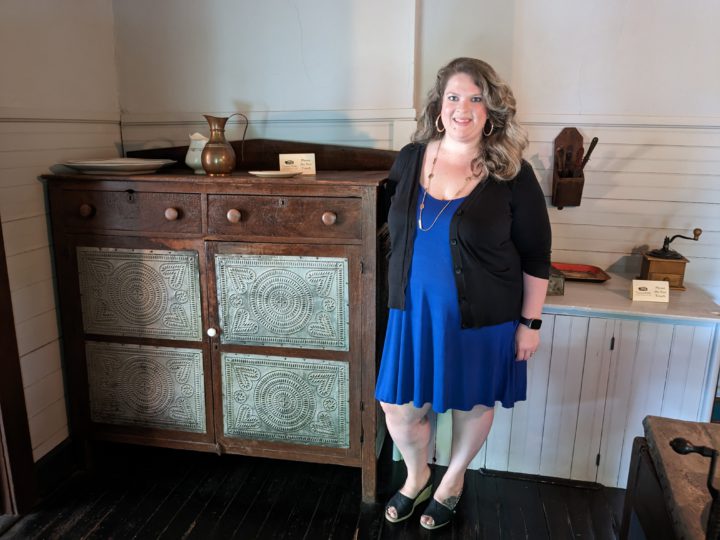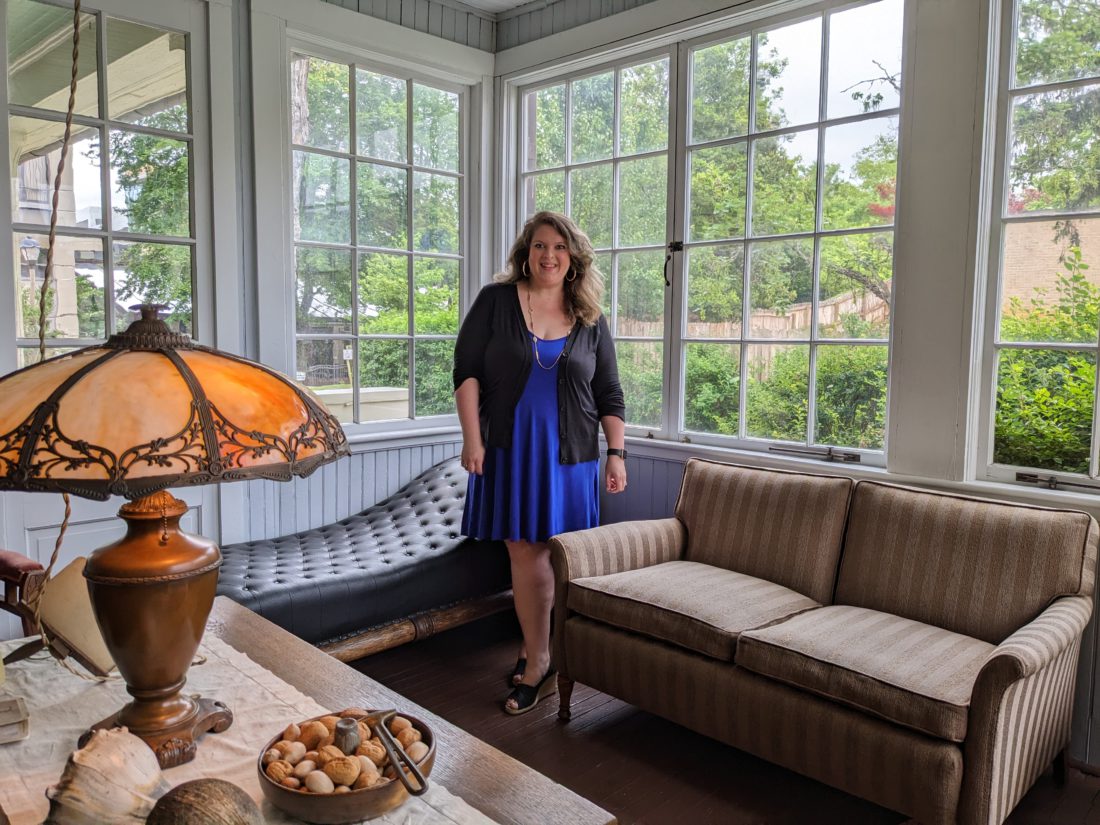Xpress returns for the second round of its new feature, “Look Homeward.” The series is inspired by the show “One True Podcast,” which invites historians, artists, writers and scholars to discuss the life and work of Ernest Hemingway. “Look Homeward” strives to do something similar, albeit with a Western North Carolina bend. Rather than Hemingway, we are focused on writer Thomas Wolfe, though future plans call for conversations about additional influential writers such as Wilma Dykeman, John Ehle and O. Henry.
For our inaugural piece with author Terry Roberts, see “Look Homeward: A New Monthly Series on WNC Writers,” April 26, Xpress.
In this month’s column, we speak with Kayla Seay. Born in Asheville and raised in Maggie Valley, Seay has worked at the Thomas Wolfe Memorial since 2016 and has served as historic interpreter III and assistant site director. The memorial, at 52 N. Market St., offers tours of the Old Kentucky Home, the boardinghouse Wolfe’s mother, Julia, operated from 1906 until her death in 1945. The site was the inspiration for Thomas Wolfe’s 1929 debut novel, Look Homeward, Angel.
Xpress: What is the one Wolfe sentence that you think best represents the author and why?
Seay: In Look Homeward, Angel, Wolfe writes: “We can’t turn life back to the hours when our lungs were sound, our blood hot, our bodies young. We are a flash of fire — a brain, a heart, a spirit.” This is not only my favorite line from Wolfe but also represents his short, but prolific life.
For readers less familiar with Wolfe, would you mind touching on some of his achievements within his brief 37 years?
I think Wolfe was prolific in many ways — from the sheer magnitude of his writing to his numerous trips abroad. From my perspective, these two things were arguably his obvious passions in life and consumed significant amounts of his time, energy and money.
From the time he graduated Harvard in 1923 until his premature death at 37 in 1938, he had traveled abroad seven times and produced thousands of longhand-written manuscript pages. The later publication of his pocket journals, spanning from his last bits of time at Harvard through his last year of life, show how he jotted down everything — from grocery lists to rough drafts of letters, to bits of dialogue and chapter outlines for his novels.
I believe Wolfe was a sponge, and he absorbed all he could from the world around him: the people, the smells, the sounds, the weather. He then put all of that back into his writing. There is a certain movement to his words, where all these different aspects he has absorbed seem to really shine and work together. Wolfe is an author who can paint a picture like no other.
Although he only saw two of his novels come to fruition in his time, the sheer volume of writing he left behind served as the scaffolding used to build his last two novels — The Web and the Rock and You Can’t Go Home Again — published posthumously.
When did you first become aware of Wolfe and how, if at all, did that draw you to working at the memorial?
My relationship with Wolfe began 10 years ago, when I took an internship as a graduate student in public history. I was born here and grew up in Maggie Valley, so I was familiar with who Wolfe was in a very limited scope, but I had never read any of his works. I’m sad to say I had never taken a tour of the historic house nor benefited from a field trip here as a student in the local schools, either.
Leading up to my internship, the site director at the time said, “We basically have two requirements — read our interpreter’s handbook, and then you’ve got to read the ‘big ’un’: Look Homeward, Angel.” I thought to myself: “Easy peasy, no problem — I’ve read tons of big, long books as a historian.”
Well, about 80 pages in, I remember looking up from the book and staring off into my living room trying to grasp at what I’d read — the flow to his words, the detail, his long and superfluous sentences that danced around the point but never seemed to quite get there. I came to two realizations: I understood quite quickly why he’s not as widely read as some of his more concise contemporaries such as F. Scott Fitzgerald and Ernest Hemingway; and I also knew, without a doubt, that I was hooked and I would see it through even if it killed me.
I’m seeing you survived the experience.
Yes, it didn’t kill me, thankfully. It made me even more eager to learn more about him and his family. That’s the beauty of reading something that is autobiographical fiction; while he certainly tweaked things and took creative liberties, we see so closely how the pages of the novel trace his youth, experiences and his family. It’s extraordinary, and rare, when you can look at something on the page and then corroborate it with other records and resources we have on-site. I now couldn’t imagine Asheville without the context of his prose.
As a historian and someone native to the area, what, if anything, has Wolfe’s fiction taught you about Asheville and Western North Carolina that you didn’t previously know?
Growing up in the area, I’d like to say I understood the importance of tourism as a main industry here. Looking at both our site records and histories of the area, Wolfe’s writings shed a brighter light on how prolific health tourism was specifically and how that significantly escalated with the arrival of the railroad in the 1880s. Prior to the railroad, it took a lot of money to make way across the mountain ridges, but folks desired a place that provided a cool escape from the heat of the deeper south and coast as well as the seasonal threats of malaria and yellow fever.
Once the railroad came through and people could travel so much easier and more affordably into Western North Carolina, you can see sanitariums and health resorts bloom in this area, along with boardinghouses. Because doctors put so much stock into climate as a cure at that time, we can also see the heavy promotion of Asheville as an ideal destination for the treatment of tuberculous and for respiratory health. Through Wolfe’s work we get a better sense of just how dramatically this changed Asheville’s landscape and how, despite the printing of “no sick people” on his mother’s business cards, tuberculosis seemed to find its way into many of the city’s businesses and public spaces.
Speaking of the boardinghouse, is there a particular room you love most?
Of the 29 total rooms in the historic house, the sun parlor is my absolute favorite, hands down. Wall-to-wall windows create a perfect space of light and cheer, even on an otherwise overcast, dreary day. This room provided boarders a space to spread out and socialize while waiting on meals, and with the piano and gramophone, it was a room of entertainment before guests retreated to their bedrooms.
The very open-air nature of the room is also a nod to the importance that guests placed on Asheville’s climate and healthy, healing mountain air. Although our view has changed drastically over the years, you can walk up to one of the wavy window panes and better put yourself in Thomas’ shoes as you gaze out onto the old Spruce Street. You can hear the tinkling of the piano keys if you try hard enough, and you can easily picture the boarders sipping their cups of coffee and reading the newspaper on the chaise or loveseat before heading out for the day.
What about the furniture? Do you have a favorite piece?

As far as historic homes go, we are beyond fortunate to have a little over 85% of the original furnishings and artifacts inside the house, and for that reason alone, there are many, many beautiful pieces to admire. But of all the beds, dressers, tables and chairs, the single piece of furniture that I can’t get enough of is the pie safe in the kitchen. It’s a source of bemusement for many guests as they look over the intricately punctured tin panels and marvel over its size and use. On the whole, most traditional pie safes were tall but relatively shallow, with shelving protected by tin-paneled doors. Usually punctured into some sort of design, these allowed baked goods to breathe while protecting them from critters and insects. The one in the boardinghouse’s kitchen is much deeper and is no doubt a nod to the amount of baked goods stored there for the large number of boarders over the years. I am 100% certain I love this pie safe because I am the keeper of my family’s pie safe, one of the few antique pieces I have that dates back to the late 1800s.
Lastly, what book or story collection would you recommend the Wolfe-curious start with and why?
If you’re interested in Wolfe but not quite sure where to start, there are two schools of thought on that. Some folks recommend jumping right into the deep end, much like I did, by tackling Look Homeward, Angel. If you’re local and can plan a visit, it works wonders to come and learn about Thomas and his family and to see the historic house. As a deeply autobiographical writer, learning about and seeing these things really helps the novel come to life so you can parallel the fact with the fiction.
Although maybe lesser known by comparison, Wolfe has many wonderful short stories to serve as an excellent starting point. This allows folks a chance to dip their toe in the pond rather than diving straight in — you get a feel for his beautiful prose and attention to detail, but the end is in sight! In his novella The Lost Boy, Wolfe fictionalizes his family’s trip to the 1904 St. Louis World’s Fair. Told in four parts, he revisits the death of his brother while they were there, and his return trip back years later. It’s a moving piece as we see the protagonist grapple with two themes that many readers connect to as universal experiences — the fading of memories and the death of a loved one.
For more on the Thomas Wolfe Memorial, visit avl.mx/cpx.





Before you comment
The comments section is here to provide a platform for civil dialogue on the issues we face together as a local community. Xpress is committed to offering this platform for all voices, but when the tone of the discussion gets nasty or strays off topic, we believe many people choose not to participate. Xpress editors are determined to moderate comments to ensure a constructive interchange is maintained. All comments judged not to be in keeping with the spirit of civil discourse will be removed and repeat violators will be banned. See here for our terms of service. Thank you for being part of this effort to promote respectful discussion.